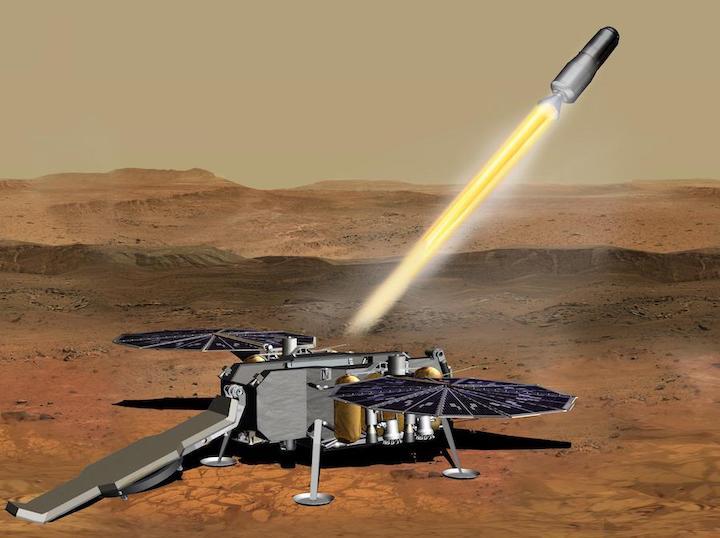31.03.2021

NASA awarded Northrop Grumman a contract worth as much as $84.5 million earlier this month to supply rocket motors for a first-of-its-kind launch vehicle to fire a capsule of rock samples off of Mars on a journey back to Earth.
The Mars Ascent Vehicle will fly to the Red Planet on a robotic mission scheduled for launch in 2026. The mission’s objective is to collect rock specimens gathered by NASA’s Perseverance rover, which landed on Mars last month.
Elements of the Mars Sample Return mission are scheduled for launch on two rockets in 2026. One part of the mission will launch on a U.S. rocket, and deliver to the Martian surface a rover to fetch the samples gathered by Perseverance, along with a makeshift launch pad and the Mars Ascent Vehicle.
The rover will load the rock specimens into capsule on top of the rocket. Then the Mars Ascent Vehicle will fire the sample canister into orbit around the Red Planet, where a European Space Agency spacecraft will rendezvous with the sample carrier.
The European orbiter will snag the sample and seat it for return to Earth. If all goes according to plan, the entire campaign to bring home Mars specimens will cost about $7 billion, and the materials could be back on Earth by 2031.
One of the untried mission elements required for the Mars Sample Return program is the rocket that will boost the rock specimens off of the Red Planet.
Northrop Grumman won the Mars Ascent Propulsion System, or MAPS, contract to “provide propulsion support and products” for the Mars Sample Return program,” NASA announced March 4. NASA said the cost-plus, fixed-fee contract has a potential mission services value of $60.2 million and a maximum potential value of $84.5 million.

“The Martian environment will be a significant factor in the design, development, manufacturing, testing, and qualification of two different solid rocket motors with multiple deliveries of each,” NASA said in a statement. “Through the MAPS contract, Northrop Grumman will provide the propulsion systems for the MAV, as well as other supporting equipment and logistics services.”
“We are committed to help build the rockets that will orbit the samples Perseverance collects so they can be returned to Earth,” said Rebecca Torzone, vice president of missile products at Northrop Grumman. “We play a vital role with NASA, as we have for decades, by providing key propulsion and control subsystems in support of human spaceflight and robotic exploration missions.”
Based on preliminary design constraints, the Mars Ascent Vehicle can be no taller than 9.2 feet (2.8 meters) and no wider than 1.9 feet (57 centimeters). Its total liftoff mass must not exceed 881 pounds (400 kilograms).
Martian gravity is just 38 percent that of Earth, meaning a rocket designed to launch a payload into orbit can be much smaller on Mars. And the MAV only has to deliver some 30 to 35 pounds (14 to 16 kilograms) of payload into orbit around Mars.
The requirements stack up to create a MAV concept that is tiny by launch vehicle standards, but it’s just enough to do the job, according to NASA engineers. After initially looking at a single-stage hybrid propulsion rocket design, engineers at NASA’s Marshall Space Flight Center in Huntsville, Alabama, determined a two-stage, solid-fueled rocket is the best choice for the Mars Ascent Vehicle.
Last year, NASA officials said the selection of the Perseverance rover’s landing site in Jezero Crater, which will also be the MAV’s launch site, allowed engineers to consider a solid-fueled rocket design. Located near the Martian equator, Jezero is home to a dried-up lake and river, which scientists believe may preserve signatures of ancient life.
Jezero’s climate is warmer than other locations considered for Perseverance’s landing, making it more amenable for solid rocket motors, which consume pre-packed propellants. Jim Watzin, the former head of NASA’s Mars exploration program, said last year that solid rocket motors are “very much a known and established entity.”
“We made a selection to go with something that we know and understand, that was not necessarily going to have a big challenge with the new, revised temperature limits that we’re going to face,” Watzin said.
The MAV will launch in mid-2026 with the U.S.-built Sample Retrieval Lander and a European fetch rover. Under current mission plans, the rocket won’t be fired until mid-2029 to begin the return trip to Earth.
Northrop Grumman supplies solid-fueled rocket motors for military missiles and satellite launchers, which are sometimes stored for decades before use. The MAV stages will launch pre-loaded with solid propellants.
Thiokol Propulsion, which is now part of Northrop Grumman after a series of corporate acquisitions, developed a solid rocket motor for NASA’s Magellan spacecraft that successfully fired after more than 15 months in space to place the probe into orbit around Venus in 1990.
According to NASA, Northrop Grumman owns a proprietary solid propellant formulation that could be used for the Mars Ascent Vehicle.
Northrop Grumman said in a statement will provide a variant of its Star-class solid rocket motors for the first and second stages of the Mars Ascent Vehicle, plus the first stage’s thrust vector control steering system and small rockets for spin stabilization of the second stage.
Quelle: SN

